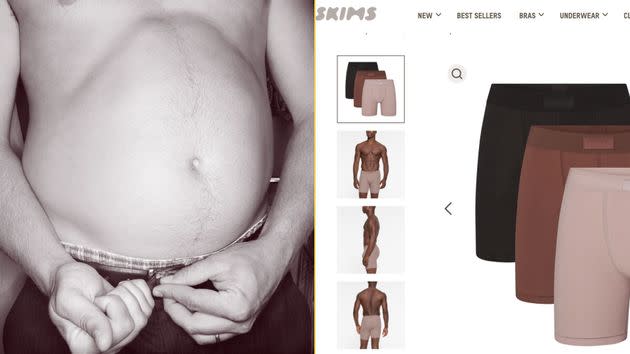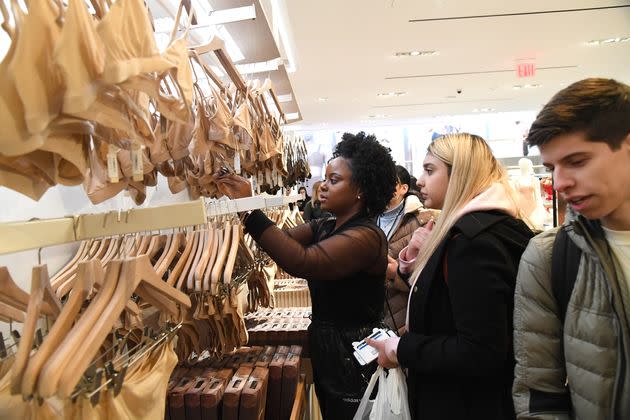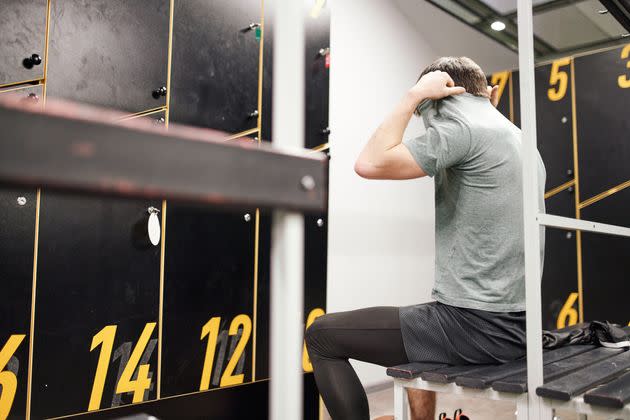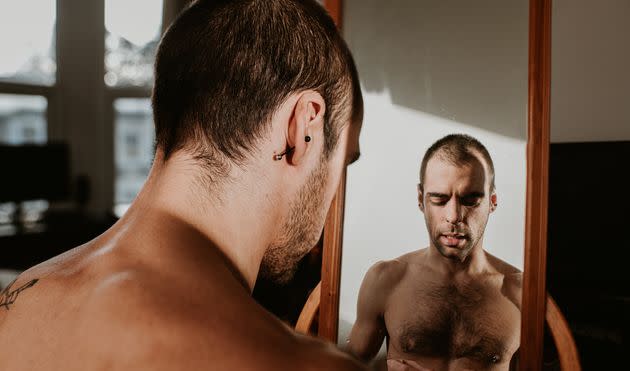Men's Shapewear Is Here, But Will Men Actually Wear It? We Asked Them.

Love it or hate it, it looks like shapewear is here to stay.
Like the corsets of yore, today’s shapewear is meant to smooth out the body, giving the wearer a more lifted, cinched-in silhouette. Celebrities who’ve posted behind-the-scenes Spanx selfies include Katy Perry, Padma Lakshmi, Karlie Kloss and Chrissy Teigen.
The compression and shapewear market size has grown substantially in the last few years. Some market experts predict it will grow from $4.8 billion in 2023 to $5.17 billion in 2024, at a compound annual growth rate of 7.8%.
But not everyone’s a fan. “Spanx are a sausage casing that hides your fat in your spleen,” actor and comedian Nancy Lee joked in 2017. (To be fair, shapewear is considerably more comfortable these days.)
For years, Spanx was the big name in the game, but Skims, launched by Kim Kardashian in 2019 and marketed as a “solution-oriented” sculpting shapewear, was valued at $4 billion in 2023.
Skims’ latest gamble? Shapewear for guys. (Understandable, given that men’s underwear is a $5.7 billion market, with sales up 2% over the past year, according to Circana consumer tracking data.)
In October, the company launched Skims Mens, a lineup that includes briefs, undershirts, boxers and leggings. Prices range from $16 to $54, depending on the item, and the sizes are extensive and body inclusive.
“Twenty percent of our traffic, and 10% of our customers, are already men,” Skims co-founder Jens Grede told GQ at the time. “That means we’ve had 50 million men coming to [the] site over the last few months.”
I think men are just as unhappy with their shapes as women are, so I’m not surprised that there is a demand for it among guys.Nick Steele, a YouTuber who has tried shapewear
The company’s initial ad campaign for the line featured high-profile athletes ― soccer star Neymar Jr., the NFL’s Nick Bosa and NBA All-Star Shai Gilgeous-Alexander ― all tugging up their shirts to reveal their Skims.
A later ad campaign, featuring megastar singer Usher, catered to girlfriends and wives buying Skims for the men in their lives.
Though the ads made a big splash, shapewear for men is actually nothing new. Thirteen years ago, The New York Times’ style section declared that “Men’s ‘Shapewear’ Is a Retail Hit.”
“We are selling them as quickly as Spanx can make them,” Nickelson Wooster, then the men’s fashion director at Neiman Marcus, told the Times.
Back then, shapewear for men was mostly limited to compression tops or body-skimming shirts that made ample use of elastane, better known as Spandex. (There’s also long been gender-affirming shape and compression wear for trans men, like chest binders.)
Today, brands like Under Armour, Leo by Leonisa and Fabletics offer a wide range of items meant to help men smooth out lumps and bumps: bodysuits, vests, padded tank tops and more.

The offerings are growing, but the share of sales that men’s shapewear brings in is still comparatively meager, said Kayla Marci, a senior fashion and retail analyst at EDITED, a global retail analytics firm.
“Key shapewear players continue to direct assortments towards women, with menswear accounting for only 5% and 10% of ranges at Skims and Leonisa, respectively,” she said.
It’s going to be a hard sell to get most men to consider shapewear, said Jennifer Lund Mahoney, a Chicago-based men’s personal stylist and shopper.
“I have been in the men’s apparel field for over 20 years and been a stylist for 11 years, and I have only encountered two men that actually had a men’s shapewear shirt,” she told HuffPost. “Neither of them liked it much or wore it regularly.”
To counter any male buyer hesitance, Skims has leaned into promoting its men’s line as sporty “activewear,” Marci said: Wear it in the gym or when you want to smooth things out in that tux you’re wearing to your buddy’s wedding.
Last year, Skims and the NBA agreed to a multiyear partnership that made Skims the “official underwear partner” of the NBA, the WNBA and USA Basketball.
“That, along with the ad campaign featuring Neymar and other athletes, gives the brand a broader reach than traditional ‘shapewear,’” Marci said.
Men who use compression wear say it’s a ‘game changer’
Anecdotally, the strategy seems to be effective. On TikTok and YouTube, you’ll find videos of Gen Z-ers giving their impression of Skims, most of them talking about how they wear the products at the gym or while playing basketball.
“The reason I got into it was because I saw that they partnered up with the NBA,” said Eugene Kim, who created a Skims try-on video on YouTube for his product review channel Supreme Value. “Then for some reason it sparked me to critically think about my underwear and I realized that I never cared to wear nice quality underwear, so I figured I would give it a try.”
Compression wear is more intimate than outerwear and I think men have been conditioned to not have these concerns about their bodies.Lee Massey, a man who has been wearing shapewear for about three years
For Kim, it’s not about creating a compressed look ― it’s more about wanting to up his game when it comes to underwear and other basics like T-shirts, sweats and hoodies.
“You obviously wear them a lot more, and I see the value in investing in them,” he told HuffPost.
John Glaude, a fitness influencer, has used compression wear during his workouts for about 10 years, after he lost more than 150 pounds.
“To be able to run and jump without the discomfort of my skin moving around has been a game changer,” he told HuffPost. “I just wear it in the gym, though. I keep it pretty tight, so it would be quite uncomfortable to wear all day.”
Glaude wears a compression top and compression shorts or tights whenever he’s running or doing an intense HIIT workout.
“I never had any apprehensions about wearing it because it just seemed like a good solution to a problem I had,” he said.

Nick Steele, who runs the YouTube channel Fat Guy Reviews, thinks the demand for shapewear ― or at least curiosity about it ― is growing even outside of gym-goers, at least based on his comments and direct messages.
“A lot of the comments I get are from guys wondering how it works: Will it help to compress some excess skin they have from rapid weight loss? Will it make them look thinner?” he told HuffPost.
For many Americans, the pandemic led to a little extra weight gain ― the COVID 15, as people jokingly called it ― which exacerbated many guys’ existing body image concerns. Though much of the research on body dissatisfaction focuses on women, some surveys estimate that around 28% of men aged 18 and over regularly struggle with their body image.
For women, the ideal is thin or, more recently, “slim thick,” à la the Kardashians. For men, the ideal body tends to be muscular but lean or athletic.
Compression wear helps them achieve that look. Steele said he’s had people thank him for demonstrating compression wear in his videos, since up to this point, there’s been very little talk about how shapewear looks on real men, or what your best bet is money-wise.
“I think men are just as unhappy with their shapes as women are, so I’m not surprised that there is a demand for it among guys,” Steele said. “Hopefully the more high-profile ad campaigns will take away some of the embarrassment that some men feel about wearing shapewear ― I’m all for that.”

Steele bought shapewear to do a review video; he’s not particularly passionate about it himself. He wears his for special occasions and, recently, to fit better into a slightly snug Jedi costume he’s worn for a Comic Con-type event.
As for recommendations, he says he generally favors the shirts over the shorts, which tend to roll down when you sit, as any woman who’s worn Spanx will attest.
“There is no hiding them after you get up and have to adjust them,” he said. “My fit advice would be to choose a size smaller than your normal shirt size. I’ve tested a few brands and that seems to be the main takeaway. If you always wear a XXL, get an XL compression shirt.” (Be careful with sizing, though: Too-snug shapewear can make it hard to breathe and can even lead to digestive problems like acid reflux.)
Lee Massey has been wearing shapewear for about three years, generally when he exercises or if he has to fit into a tuxedo or a suit for formal events. He likes Skims best. Among his guy friends, he’s sensing more interest.
“Compression wear is more intimate than outerwear and I think men have been conditioned to not have these concerns about their bodies,” Massey said.
He thinks that’s slowly starting to change, though. “I think men are getting into shapewear because the negative connotation or stigma surrounding men entering ‘women’s’ spaces is diminishing greatly,” he said.
I don’t think it puts off losing weight. If anything, it helps me visualize aesthetic goals that I can obtain. I have no complaints.Massey
Negative connotations still exist, though. In Reddit communities centered on men’s fashion and weight loss, the criticism men face when they ask for shape and compression wear recommendations isn’t usually gender-based. Rather, critics in the comments tend to look at shapewear as “a barrier” to losing weight.
“If you don’t like the way your body looks, diet and work out,” one person said.
“Seems no different than a wonder bra. It’s false advertising,” another wrote. “If you want to be in shape, you have to work it.”
Massey and Steele take issue with that argument. They’re still working out ― they just sometimes wear compression wear.
“I don’t think it puts off losing weight,” Massey said. “If anything, it helps me visualize aesthetic goals that I can obtain. I have no complaints.”
Steele reads that kind of criticism all the time in his YouTube comment section.
“People will say, if you just go to the gym or stop eating so much, then you wouldn’t need compression shirts,” he said. “But according to my other comments, that’s not why most guys wear them. It seems like most guys are wearing them to fit into their clothes a bit better, or for pain relief.”
“With compression shirts or anything else, I always say that if you’re curious, then give it a shot,” he said.

